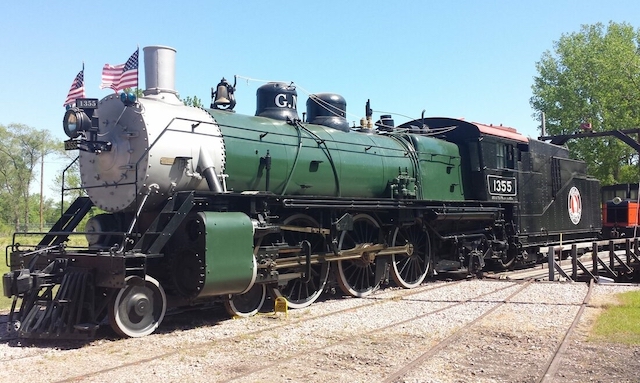
Great Northern No. 1355 sat at the foot of Sioux City’s Pierce Street for decades and is now on display in the Sioux City Railroad Museum’s roundhouse. The museum’s deputy director, T.J. Obermeyer, tabbed “Iron Horse” as one of his favorite museum pieces. “While steam locomotives in general were the lifeblood of the railroads and are an integral part of the story, our organization got its start by saving and restoring the locomotive and has since developed around that venture,” he said. Photo courtesy of Sioux City Railroad Museum
July/Aug 2023 (Volume 15, Issue 4)
By Arvid Huisman
A museum in Sioux City recalls the region’s rich heritage as a noted railroad center. In the latter part of the 19th century, eight rail lines served the community which at the time was the jumping-off point for expansion of the great Northwest.
Early in the 20th century Sioux City was the 10th largest railroad center in the nation.
Located in an area formerly home to the Milwaukee Road’s roundhouse and shops along the Big Sioux River, the Sioux City Railroad Museum offers visitors an interactive opportunity to better understand and appreciate the extensive railroad heritage of the Siouxland region.
More than 5,000 objects of railroad memorabilia are displayed on the 32-acre site.
Sioux City’s railroad heritage
Sioux City’s history is strongly intertwined with the railroad.
The railroad reached Iowa in April 1856 when the first railroad bridge across the Mississippi River at Davenport was completed. At the time Sioux City, more than 300 miles west/northwest, was still in its infancy.
A decade later with its population nearing 3,000 people Sioux City leaders recognized their city’s future heavily depended on rail access. In the fall of 1866 a group of local leaders met with a representative of John Blair who was planning on building the Sioux City and Pacific Railroad, connecting the city with a main line in Missouri Valley.
This connection to the main line some 75 miles to the south would give Sioux City connections to Chicago, Ill., and points east. The connection, however, was dependent on Sioux City and Woodbury County providing free land for the tracks and depot. A deal was struck in February 1867.
John Blair was the president of 16 railroad companies and owned the most rail mileage in the world. He built the first railroad from the Mississippi River to the Missouri River.
Locals celebrated on March 9, 1868, when the first train rolled into the city over a new bridge spanning the Floyd River.
Within a few decades a total of eight railroads were serving Sioux City and the community experienced rapid growth. From a population of 3,401 in 1870 Sioux City had grown to 37,806 by 1890.
Looking at a map of the railroads serving Sioux City in the late 19th century one can imagine a bicycle wheel with eight spokes approaching the community from different directions. Most of the railroads expanded beyond Sioux City. The Milwaukee Road, for instance, continued all the way to Seattle.
Other early railroads serving Sioux City included the Great Northern, Soo Line, Chicago & Northwestern and the Illinois Central.
Sioux City today is served by four railroads — the Burlington Northern Santa Fe, Union Pacific, Canadian National and Dakota and Iowa.
The inception of a railroad museum
Sioux City native Larry Obermeyer, Jr., is the son of a railroader. In his younger years Larry Obermeyer, Sr., had worked for the Chicago & Northwestern Railroad.
After a noon meal in February 1987 the father-son team was chatting in the Southern Hills Mall food court in Sioux City when they encountered an acquaintance from the railroad industry. The colleague advised that the retired Great Northern steam locomotive that was a community landmark at the base of Sioux City’s downtown for decades was potentially slated to be moved to another community.
The father-son pair had discussed a railroad museum in the past, but the fear of losing the landmark Iron Horse locomotive prompted the men to action and at a food court table they sketched the initial plans for the Sioux City Railroad Museum on a paper napkin.
Eventually the Siouxland Historical Railroad Association was born. It would be several years, however, before a railroad museum was a reality.
TO READ THE ENTIRE STORY AND OTHER FASCINATING STORIES ABOUT IOWA HISTORY, subscribe to Iowa History Journal.
